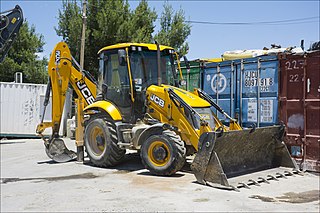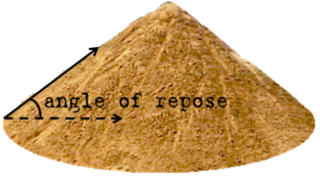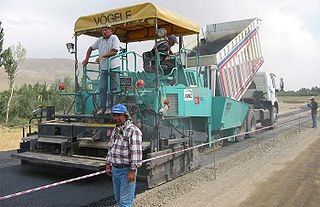
The free floating screed is a device pioneered in the 1930s that revolutionized the asphalt paving process. The device is designed to spread and smooth out, or screed, the material (e.g. concrete or asphalt) below it.

The free floating screed is a device pioneered in the 1930s that revolutionized the asphalt paving process. The device is designed to spread and smooth out, or screed, the material (e.g. concrete or asphalt) below it.
The screed connects to the tractor portion of the paving machine via its tow arm. Paving material is transferred from the hopper at the front of the tractor to the screed, and augers spread it across the width of the screed. The material then flows out across the width of the screed at the desired depth. A screed operator stands on a platform at the center of the screed and controls the placement of the paving mixture. Adjusting screed settings will change the placement depth and width, as well as amount of material being placed. Many modern screeds can be run in an automatic mode, too. [1]
Because the only connection between the asphalt paver and the screed is the tow arm, the screed can "float" vertically relative to the paver. This allows the paver to traverse uneven ground while the screed floats over the material placed in front of it.
The free floating screed has become standard because of the smoothing or averaging effect it can have on the existing base course. The free floating screed has a number of forces acting on it that, when in equilibrium, allow the depth behind the screed to be constant.
The angle at which the tow arm pull is exerted on the screed also contributes to the motion; its resultant force is either added or subtracted from the mass of the screed.
If each of these forces is constant, altering the angle of the screed to the horizontal (angle of attack) will control the amount of material extruded behind the screed. Increasing the angle of attack will cause the screed to climb higher through the pile of material, and therefore raise its trailing edge, increasing the amount of material extruded behind the screed. Similarly, reducing the angle of attack will reduce the amount of material extruded. [2]
The free floating screed was first developed by Harry H. Barber, one of the founders of the Barber-Greene Co., in 1933 for which he received patent number US 2138828A ("Machine for and process of laying roads") three years later. Barber Green dominated the market for free floating screed equipment until the patent expired in 1955, [3] and now all major asphalt paver manufacturers use this design principle in their equipment.

A road surface or pavement is the durable surface material laid down on an area intended to sustain vehicular or foot traffic, such as a road or walkway. In the past, gravel road surfaces, macadam, hoggin, cobblestone and granite setts were extensively used, but these have mostly been replaced by asphalt or concrete laid on a compacted base course. Asphalt mixtures have been used in pavement construction since the beginning of the 20th century and are of two types: metalled (hard-surfaced) and unmetalled roads. Metalled roadways are made to sustain vehicular load and so are usually made on frequently used roads. Unmetalled roads, also known as gravel roads, are rough and can sustain less weight. Road surfaces are frequently marked to guide traffic.

Buoyancy, or upthrust, is an upward force exerted by a fluid that opposes the weight of a partially or fully immersed object. In a column of fluid, pressure increases with depth as a result of the weight of the overlying fluid. Thus the pressure at the bottom of a column of fluid is greater than at the top of the column. Similarly, the pressure at the bottom of an object submerged in a fluid is greater than at the top of the object. The pressure difference results in a net upward force on the object. The magnitude of the force is proportional to the pressure difference, and is equivalent to the weight of the fluid that would otherwise occupy the submerged volume of the object, i.e. the displaced fluid.
Archimedes' principle states that the upward buoyant force that is exerted on a body immersed in a fluid, whether fully or partially, is equal to the weight of the fluid that the body displaces. Archimedes' principle is a law of physics fundamental to fluid mechanics. It was formulated by Archimedes of Syracuse.

Asphalt concrete is a composite material commonly used to surface roads, parking lots, airports, and the core of embankment dams. Asphalt mixtures have been used in pavement construction since the beginning of the twentieth century. It consists of mineral aggregate bound together with bitumen, laid in layers, and compacted. The process was refined and enhanced by Belgian-American inventor Edward De Smedt.

A backhoe loader, also called a loader backhoe, loader excavator, tractor excavator, digger or colloquially shortened to backhoe within the industry, is a heavy equipment vehicle that consists of a tractor-like unit fitted with a loader-style shovel/bucket on the front and a backhoe on the back. Due to its (relatively) small size and versatility, backhoe loaders are very common in urban engineering and small construction projects as well as developing countries. This type of machine is similar to and derived from what is now known as a TLB (Tractor-Loader-Backhoe), which is to say, an agricultural tractor fitted with a front loader and rear backhoe attachment.

Heavy equipment, heavy machinery, earthmovers, construction vehicles, or construction equipment, refers to heavy-duty vehicles specially designed to execute construction tasks, most frequently involving earthwork operations or other large construction tasks. Heavy equipment usually comprises five equipment systems: the implement, traction, structure, power train, and control/information.

The angle of repose, or critical angle of repose, of a granular material is the steepest angle of descent or dip relative to the horizontal plane on which the material can be piled without slumping. At this angle, the material on the slope face is on the verge of sliding. The angle of repose can range from 0° to 90°. The morphology of the material affects the angle of repose; smooth, rounded sand grains cannot be piled as steeply as can rough, interlocking sands. The angle of repose can also be affected by additions of solvents. If a small amount of water is able to bridge the gaps between particles, electrostatic attraction of the water to mineral surfaces increase the angle of repose, and related quantities such as the soil strength.

A grader, also commonly referred to as a road grader, motor grader, or simply a blade, is a form of heavy equipment with a long blade used to create a flat surface during grading. Although the earliest models were towed behind horses, and later tractors, most modern graders are self-propelled and thus technically "motor graders".

A baler or hay baler is a piece of farm machinery used to compress a cut and raked crop into compact bales that are easy to handle, transport, and store. Often, bales are configured to dry and preserve some intrinsic value of the plants bundled. Different types of balers are commonly used, each producing a different type of bale – rectangular or cylindrical, of various sizes, bound with twine, strapping, netting, or wire.
This page is a list of construction topics.

A road roller is a compactor-type engineering vehicle used to compact soil, gravel, concrete, or asphalt in the construction of roads and foundations. Similar rollers are used also at landfills or in agriculture.

A paver is a piece of construction equipment used to lay asphalt concrete or Portland cement concrete on roads, bridges, parking lots and other such places. It lays the material flat and provides minor compaction. This is typically followed by final compaction by a road roller.

A pugmill, pug mill, or commonly just pug, is a machine in which clay or other materials are extruded in a plastic state or a similar machine for the trituration of ore. Industrial applications are found in pottery, bricks, cement and some parts of the concrete and asphalt mixing processes. A pugmill may be a fast continuous mixer. A continuous pugmill can achieve a thoroughly mixed, homogeneous mixture in a few seconds, and the right machines can be matched to the right application by taking into account the factors of agitation, drive assembly, inlet, discharge, cost and maintenance. Mixing materials at optimum moisture content requires the forced mixing action of the pugmill paddles, while soupy materials might be mixed in a drum mixer. A typical pugmill consists of a horizontal boxlike chamber with a top inlet and a bottom discharge at the other end, 2 shafts with opposing paddles, and a drive assembly. Some of the factors affecting mixing and residence time are the number and the size of the paddles, paddle swing arc, overlap of left and right swing arc, size of mixing chamber, length of pugmill floor, and material being mixed.

The Miller Group is a diverse transportation construction company based in Markham, Ontario, Canada where its Corporate Head Office is located. Its U.S. headquarters is located in Morrow, Georgia.

The Meillerwagen was a German World War II trailer used to transport a V-2 rocket from the 'transloading point' of the Technical Troop Area to the launching point, to erect the missile on the Brennstand, and to act as the service gantry for fuelling and launch preparation.

Screed has three meanings in building construction:

Blaw-Knox is a manufacturer of road paving equipment. The company was created in 1917 from the merger of Blaw Collapsible Steel Centering Company and the Knox Pressed and Welded Steel Company. Blaw-Knox was sold to new owners in 1968, changed owners a few times thereafter, and continues as the Volvo Blaw-Knox brand of paving equipment, sold to Volvo Construction Equipment since 2007. Since July 2020 it is owned by Gencor Industries Inc.

A barrel shroud is an external covering that envelops the barrel of a firearm, to prevent unwanted direct contact with the barrel. Moving coverings such as pistol slides, fore-end extension of the gunstock/chassis that do not fully encircle the barrel, and the receiver of a firearm itself are generally not described as barrel shrouds, though they can functionally act as such.

Barber-Greene Company was a company founded in 1916 by American mechanical engineers Harry H. Barber and William B. Greene. It was formed to sell standardized material-handling machines to mechanize small manual tasks in an economical way. Though the company began by offering conveyors and bucket loaders, it is best known for its contributions to the asphalt field. In 1959, the company went public and was sold to Astec in 1986.
CMI Roadbuilding, Inc. of Oklahoma City began in 1961, when engineers headed by Bill Swisher started looking for new methods in the road building industry. Little had changed since the early 1900s in the methods of building roads, however, labor costs were skyrocketing and inflation meant taxpayers dollars were buying less and less. In the same period Society was becoming increasingly more mobile creating demand for better roads and highways. The CMI group believed that many road failures were due to poor riding surface which was mainly caused by inaccuracies in the subgrade.